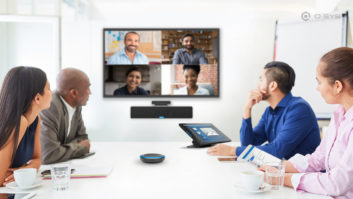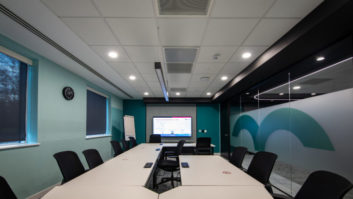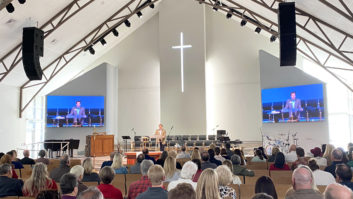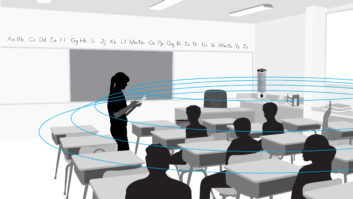
Previously we provided an overview of developments across audio networking, before considering the impact the success of Dante has had on the wider market in part two. Phil Ward concludes by moving onto how audio and video will interact.
At InfoComm in June, Harman demonstrated ‘breakaway’ audio from its video-to-audio devices via the AES67 Layer 3 protocol suite, a phrase with subliminal suggestions of audio ‘escaping’ a ring of control and making its own way in an unpredictable world. What this means in practice, as expressed by Adam Holladay, director of solutions, marketing & hospitality at Harman International, is that “we just found the easiest way to do it”. What’s more, it doesn’t even matter whether or not the industry has achieved the utopia of an open standard…
“There are mechanisms today by which you can connect one device to another and the audio moves between them – it’s that simple,” Holladay states. “The industry can have as many protocols as it likes, open or so-called proprietary, but we have got beyond the argument as to which one works best. Dante has certainly won out from an adoption perspective – fantastic for someone wanting to build a network as there’s now so much choice – but they all work. What matters most is simply how easy it is to get it working in the first place.”
Customers need to encourage manufacturers to fully embrace the complete AES67 standard
Martin Barbour, QSC
The legacy of CobraNet, the first open-architecture DSP product, has emerged within QSC. Those that pioneered this technology, including Rich Zwiebel and much of the original Peak Audio team, now work for QSC and developed the Q-SYS platform. From the outset, the requirement of Q-SYS was to connect various audio, video and control (AV&C) peripherals together under a single ecosystem, so the team developed a networking technology they called Q-LAN. This in-house networking development effort of course provides all the autonomy and agility QSC requires from a networking standpoint but, according to Martin Barbour, product manager for installed systems at QSC and co-chairman of the Marketing Working Group at the Media Networking Alliance (MNA), it was “never intended to lock other manufacturers out. The intent with Q-LAN was simply to allow QSC to develop the most appropriate networking technology for our target market upon which the Q-SYS Platform could be built. This allowed us the ability to quickly develop, change and improve the networking components at our own pace, and as needed.”
He continues: “Our strategy was to maximise audio, video and control capabilities over a standard, modern IT network within our own ecosystem, and we quickly added third-party interface cards for Dante, CobraNet and AVB to provide interoperability with other non-QSC products and systems. QSC has recently added native AES67 integration to the Q-SYS Platform as well. The nice thing about AES67 with Q-SYS is that we were able to implement it directly onto our built-in network ports without any additional hardware; it was all done at the software level. For our customers, it’s a simple firmware upgrade and they can run this complete suite of networking technology concurrently within the same system.”
QSC believes the next phase of AES67 will come as various manufactures mature their implementation of AES67. The goal is to ease the setup of bidirectional audio streams as well as employ unicast streaming as its defined by the standard. “Unicast is much easier for IT professionals to deal with on a network – particularly those who have concerns about network management and security,” Barbour points out. “Customers need to encourage manufacturers to fully embrace the complete AES67 standard to provide an open, interoperable solution that is IT friendly and built for scalability on an enterprise level. In terms of audio transport, AES67-enabled products can exchange audio, albeit that requires some amount of configuration and set-up. It’s clear this process can be streamlined from an end-user’s perspective, so unified AES67 routing software applications such as ANEMA from Merging become welcome additions to the system integrator’s toolkit.”
The audio industry now has to get the video industry to talk to the ‘accepted norm’ for audio
Adam Holladay, Harman
For its own part, QSC has recently announced strategic alliances with several manufacturers, including Atlona and WyreStorm, the maker of the NetworkHD series of encoders.
Professional video encoders have also entered the broad product portfolio that includes all things HiQnet and BLU link. “The next conversation we want to be having is about the future of sharing audio with video,” affirms Harman’s Adam Holladay. “With Harman’s acquisition of SVSi we have a mandate to find a way to ensure that the video devices are transmitting audio with the same protocol that audio devices understand. When it comes to control of the two, so you can switch audio and video together, that’s the next level of differentiator for us. But the audio industry now has to get the video industry to talk to the ‘accepted norm’ for audio, so it comes off the HDMI cable and onto our networks. That’s exactly what we’re doing with BSS Audio processors and the AMX SVSi platform, and what QSC is doing with WyreStorm.”
Biscuits and chips
Ethan Wetzell, platform strategist at Bosch Communcations Systems, has a nice analogy for the continuing challenge facing AES67. “We need to continue awareness and adoption of AES70 and OCA, but then you get to the next layer of complexity: once you’ve agreed the language, you need to agree the lexicon,” he says. “You and I are speaking English, but you’re from the UK and I’m from the US. If we were having lunch and I asked you to pass me the biscuits and the chips, you’d give me something quite different to what I’m expecting! Words can mean different things in the same language, so within the trade associations we’re building definitions of what those words mean and how they can be used: mechanisms to hand over to manufacturers so they can define their devices more accurately within that lexicon.”
The aim of standardisation is to increase competitiveness, not stifle it, so this technology needs to get out of the way as soon as possible. When it does, multiple brands will appear on a level playing field. “The concept of single-source systems is rapidly disappearing,” points out Wetzell. “One subset may be a given vendor, like the voice alarm subset, but what happens when a sound engineer needs to patch in a device from a different vendor? It’s naïve to think that your system will never touch an ‘alien’ component.”
This is obvious in touring, but you might think that ‘fixed’ installation is more likely to accommodate a single ecosystem. Not so, says Wetzell. “An installation is a snapshot in time,” he says, “to meet today’s needs right now. But nobody makes everything – not even Bosch! – and the odds of something third-party being necessary are high. Furthermore, systems are getting more modular and ‘field-adjustable’, and are increasingly supplementable, exchangeable and replaceable in smaller parts, and once networking fully ‘works’, those parts will come from anywhere. Supply and demand will not be restricted by technology.”
Audio, video or control data, it shouldn’t really matter. But for as long as networking standards resist universal support, networking will be like doing a jigsaw puzzle while competing in a marathon. Let’s not do that: let’s ditch the running spikes and finish the last few pieces.






